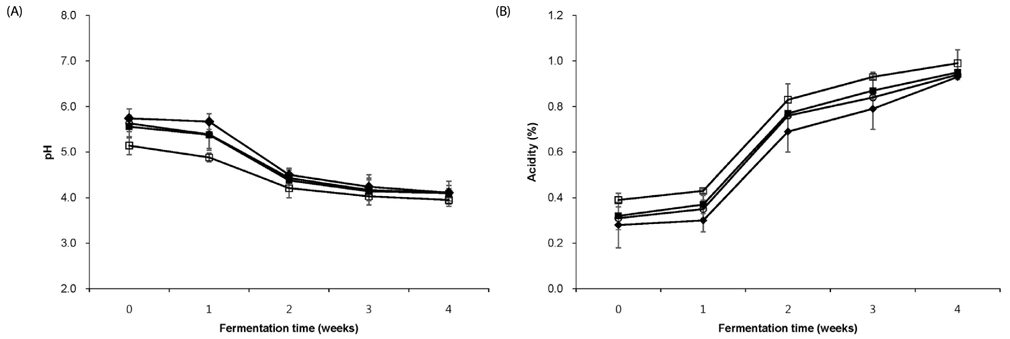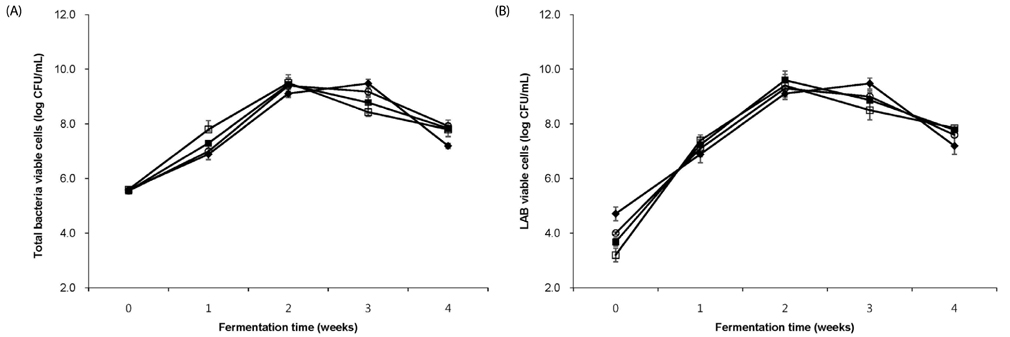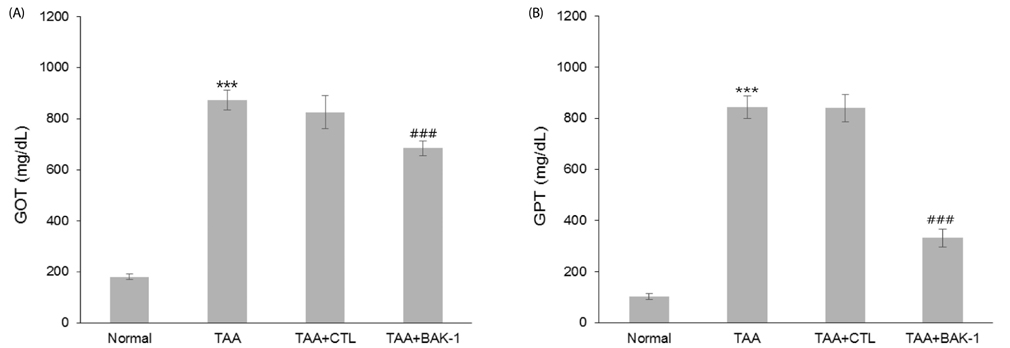Nutr Res Pract.
2019 Apr;13(2):87-94. 10.4162/nrp.2019.13.2.87.
Antioxidant effects of kimchi supplemented with black raspberry during fermentation protect against liver cirrhosis-induced oxidative stress in rats
- Affiliations
-
- 1Berry & Biofood Research Institute, Jeonbuk 56417, Korea.
- 2World Institute of Kimchi, 86 Kimchiro, Namgu, Gwangju 61755, Korea. jhjung@wikim.re.kr
- KMID: 2442365
- DOI: http://doi.org/10.4162/nrp.2019.13.2.87
Abstract
- BACKGROUND/OBJECTIVES
Oxidative stress is a major effector of various diseases; accordingly, antioxidants are frequently ingested in order to prevent or alleviate disease symptoms. Kimchi contains various natural antioxidants, and it is known that the functional activity varies depending on the ingredients and fermentation state. Black raspberries (BR) contain various bioactive compounds with antioxidant effects. This study investigated the antioxidant and liver-protection effects of kimchi supplemented with black raspberry juice powder (BJP).
MATERIALS/METHODS
BJP-added kimchi (BAK; at 0.5%, 1%, and 2% concentrations of BJP) and control (without BJP) were prepared and fermented at 4℃ for 4 weeks. Changes in the antioxidant effects of BAK during fermentation were investigated. In addition, the protective activity of BAK against oxidative stress was investigated in a liver cirrhosis-induced animal model in vivo.
RESULTS
BAK groups showed the acidity and pH of optimally ripened (OR) kimchi at 2 weeks of fermentation along with the highest lactic acid bacterial counts. Additionally, BAK groups displayed a higher content of phenolic compounds and elevated antioxidant activities relative to the control, with the highest antioxidant effect observed at 2 weeks of fermentation of OR 1% BAK. After feeding the OR 1% BAK to thioacetamide-induced liver cirrhosis rats, we observed decreased glutamate oxaloacetate transaminase and glutamate pyruvate transaminase activities and elevated superoxide dismutase activity.
CONCLUSIONS
These findings showed that the antioxidant effects of OR BAK and feeding of OR 1% BAK resulted in liver-protective effects against oxidative stress.
Keyword
MeSH Terms
-
Animals
Antioxidants*
Bacterial Load
Fermentation*
Glutamic Acid
Hydrogen-Ion Concentration
Lactic Acid
Liver Cirrhosis
Liver*
Models, Animal
Oxaloacetic Acid
Oxidative Stress*
Phenol
Pyruvic Acid
Rats*
Rubus*
Superoxide Dismutase
Antioxidants
Glutamic Acid
Lactic Acid
Oxaloacetic Acid
Phenol
Pyruvic Acid
Superoxide Dismutase
Figure
Reference
-
1. Willcox JK, Ash SL, Catignani GL. Antioxidants and prevention of chronic disease. Crit Rev Food Sci Nutr. 2004; 44:275–295.
Article2. Yang UJ, Ko SH, Shim SM. Vitamin C from standardized water spinach extract on inhibition of cytotoxicity and oxidative stress induced by heavy metals in HepG2 cells. J Korean Soc Appl Biol Chem. 2014; 57:161–166.
Article3. Lobo V, Patil A, Phatak A, Chandra N. Free radicals, antioxidants and functional foods: impact on human health. Pharmacogn Rev. 2010; 4:118–126.
Article4. Zhang Y, Tocchetti CG, Krieg T, Moens AL. Oxidative and nitrosative stress in the maintenance of myocardial function. Free Radic Biol Med. 2012; 53:1531–1540.
Article5. Jung JY, Lee SH, Lee HJ, Seo HY, Park WS, Jeon CO. Effects of Leuconostoc mesenteroides starter cultures on microbial communities and metabolites during kimchi fermentation. Int J Food Microbiol. 2012; 153:378–387.
Article6. Park KY, Jeong JK, Lee YE, Daily JW 3rd. Health benefits of kimchi (Korean fermented vegetables) as a probiotic food. J Med Food. 2014; 17:6–20.
Article7. Park JM, Shin JH, Gu JG, Yoon SJ, Song JC, Jeon WM, Suh HJ, Chang UJ, Yang CY, Kim JM. Effect of antioxidant activity in kimchi during a short-term and over-ripening fermentation period. J Biosci Bioeng. 2011; 112:356–359.
Article8. Cui M, Kim HY, Lee KH, Jeong JK, Hwang JH, Yeo KY, Ryu BH, Choi JH, Park KY. Antiobesity effects of kimchi in diet-induced obese mice. J Ethnic Foods. 2015; 2:137–144.
Article9. Kim BK, Choi JM, Kang SA, Park KY, Cho EJ. Antioxidative effects of kimchi under different fermentation stage on radical-induced oxidative stress. Nutr Res Pract. 2014; 8:638–643.
Article10. Choi H, Kim M, Park HS, Kim YS, Shin DH. Alcoholic fermentation of bokbunja (Rubus coreanus Miq.) wine. Korean J Food Sci Technol. 2006; 38:543–547.11. Tulio AZ Jr, Reese RN, Wyzgoski FJ, Rinaldi PL, Fu R, Scheerens JC, Miller AR. Cyanidin 3-rutinoside and cyanidin 3-xylosylrutinoside as primary phenolic antioxidants in black raspberry. J Agric Food Chem. 2008; 56:1880–1888.
Article12. Lee J, Whang JB, Youn NR, Lee SY, Lee HJ, Kim YJ, Koh KH. Antioxidant and oxygen radical scavenging capacities of the extracts of pear cactus, mulberry and Korean black raspberry fruit. J Food Sci Nutr. 2009; 14:188–194.
Article13. Park EK, Cho SM, Lee JE, Lee SM, Kim YS, Go MS, Kim YJ, Jung IK, Auh JH, Choi HK, Kim JH. Effects of Korean black raspberry supplementation on oxidative stress and plasma antioxidant capacity in healthy male smokers. J Funct Foods. 2015; 16:393–402.
Article14. Xiao T, Guo Z, Bi X, Zhao Y. Polyphenolic profile as well as anti-oxidant and anti-diabetes effects of extracts from freeze-dried black raspberries. J Funct Foods. 2017; 31:179–187.
Article15. Dewanto V, Wu X, Adom KK, Liu RH. Thermal processing enhances the nutritional value of tomatoes by increasing total antioxidant activity. J Agric Food Chem. 2002; 50:3010–3014.
Article16. Park SY, Jang HL, Lee JH, Choi Y, Kim H, Hwang J, Seo D, Kim S, Nam JS. Changes in the phenolic compounds and antioxidant activities of mustard leaf (Brassica juncea) kimchi extracts during different fermentation periods. Food Sci Biotechnol. 2017; 26:105–112.
Article17. Brand-Williams W, Cuvelier ME, Berset C. Use of a free radical method to evaluate antioxidant activity. Lebensm Wiss Technol. 1995; 28:25–30.
Article18. Re R, Pellegrini N, Proteggente A, Pannala A, Yang M, Rice-Evans C. Antioxidant activity applying an improved ABTS radical cation decolorization assay. Free Radic Biol Med. 1999; 26:1231–1237.
Article19. Oyaizu M. Studies on products of browning reactions: antioxidative activities of products of browning reaction prepared from glucosamine. Jpn J Nutr Diet. 1986; 44:307–315.
Article20. Seeram NP. Berries. In : Heber D, Blackburn GL, Go VL, Milner J, editors. Nutritional Oncology. 2nd ed. London: Academic Press;2006. p. 615–628.21. Om AS, Song YN, Noh G, Kim H, Choe J. Nutrition composition and single, 14-day and 13-week repeated oral dose toxicity studies of the leaves and stems of Rubus coreanus Miquel. Molecules. 2016; 21:65.
Article22. Sikora E, Cieślik E, Leszczyńska T, Filipiak-Florkiewicz A, Pisulewski PM. The antioxidant activity of selected cruciferous vegetables subjected to aquathermal processing. Food Chem. 2008; 107:55–59.
Article23. Bang BH, Seo JS, Jeong EJ. A method for maintaining good kimchi quality during fermentation. Korean J Food Nutr. 2008; 21:51–55.24. Lee JW, Cha DS, Hwang KT, Park HJ. Effect of CO2 absorbent and high-pressure treatment on the shelf-life of packaged kimchi products. Int J Food Sci Technol. 2003; 38:519–524.
Article25. Yu KW, Hwang JH, Keum JH, Lee KH. Quality characteristics of kimchi seasoning with black garlic. Korean J Food Nutr. 2016; 29:677–683.
Article26. Lee SH, Kang KM. Fermentation characteristics of tofu with kimchi seasoning. Lebensm Wiss Technol. 2014; 59:1041–1046.
Article27. Yang MR, No GR, Kang SN, Kim SW, Kim IS. Effect on cryopreservation stability of kimchi duruchigi supplemented with Rubus coreanus Miquel extract. J Life Sci. 2015; 25:1362–1369.
Article28. Kang OJ. Production of fermented tea with Rhodotorula yeast and comparison of its antioxidant effects to those of unfermented tea. Korean J Food Cookery Sci. 2010; 26:422–427.29. Ohara H, Owaki M, Sonomoto K. Xylooligosaccharide fermentation with Leuconostoc lactis. J Biosci Bioeng. 2006; 101:415–420.
Article30. Park KY, Rhee SH. Functional foods from fermented vegetable products: kimchi (Korean fermented vegetables) and functionality. In : Shi J, Ho CT, Shahidi F, editors. Asian Functional Foods. Boca Raton: CRC Press;2005. p. 341–380.31. Hajovsky H, Hu G, Koen Y, Sarma D, Cui W, Moore DS, Staudinger JL, Hanzlik RP. Metabolism and toxicity of thioacetamide and thioacetamide S-oxide in rat hepatocytes. Chem Res Toxicol. 2012; 25:1955–1963.
Article32. Salama SM, AlRashdi AS, Abdulla MA, Hassandarvish P, Bilgen M. Protective activity of Panduratin A against thioacetamide-induced oxidative damage: demonstration with in vitro experiments using WRL-68 liver cell line. BMC Complement Altern Med. 2013; 13:279.
Article33. Ozaki M, Nakamura M, Teraoka S, Ota K. Ebselen, a novel antioxidant compound, protects the rat liver from ischemia-reperfusion injury. Transpl Int. 1997; 10:96–102.
Article34. Reitman S, Frankel S. A colorimetric method for the determination of serum glutamic oxalacetic and glutamic pyruvic transaminases. Am J Clin Pathol. 1957; 28:56–63.
Article35. Crapo JD, McCord JM, Fridovich I. Preparation and assay of superoxide dismutases. Methods Enzymol. 1978; 53:382–393.36. Choi MH, Shim SM, Kim GH. Phenolic acids and quercetin from Korean black raspberry seed protected against acetaminopheninduced oxidative stress in mice. J Funct Foods. 2015; 19:404–416.
Article37. Chen J, Sun H, Sun A, Lin QH, Wang Y, Tao X. Studies of the protective effect and antioxidant mechanism of blueberry anthocyanins in a CC14-induced liver injury model in mice. Food Agric Immunol. 2012; 23:352–362.
Article
- Full Text Links
- Actions
-
Cited
- CITED
-
- Close
- Share
- Similar articles
-
- Antioxidative effects of Kimchi under different fermentation stage on radical-induced oxidative stress
- Effects of S-allylcysteine on Oxidative Stress in Streptozotocin-Induced Diabetic Rats
- Antioxidant mechanism of black garlic extract involving nuclear factor erythroid 2-like factor 2 pathway
- Antioxidant action of soy isoflavones on oxidative stress and antioxidant enzyme activities in exercised rats
- Effects of Iron Overload during Pregnancy on Oxidative Stress in Maternal Rats





